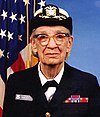Craig Gentry (computer scientist)
Craig B. Gentry (* 1972 or 1973) is an American computer scientist and cryptographer .
Gentry graduated from Duke University with a bachelor's degree and received his PhD from Harvard Law School in Law (JD) in 1998. From 1998 to 2000 he worked as a lawyer (copyright law) and from 2000 to 2005 he was Senior Research Engineer at DoCoMo USA Labs. In 2009 he received his PhD in computer science from Stanford University under Dan Boneh (A Fully Homomorphic Encryption Scheme). In 2009, his dissertation received the ACM award for best dissertation . He is a researcher in the Cryptographic Research Group at the IBM Thomas J. Watson Research Center .
In his dissertation in 2009, Gentry succeeded in solving a long (since 1978) open problem of cryptography. He found a likely candidate for a fully homomorphic encryption method (FHE, Fully Homomorphic Encryption ) that performs mathematical operations on encrypted data without using a secret key and without revealing the encrypted individual data. For example, a web application could calculate a user's tax refund without decrypting the financial data during the calculation. Gentry's breakthrough was not yet practical for broad applications, but it did lead to a wealth of further research, particularly into user security in cloud computing . With colleagues he then constructed several FHE processes, including the Brakerski-Gentry-Vaikuntanathan (BGV) process, which is available as open source (HeLib).
In 2013, he and colleagues also published the first plausible candidate for multilinear mapping for encryption and digital signatures that had been proposed for a long time (instead of the bilinear mapping that had been common up until then). In 2013, together with colleagues, he constructed the first plausible candidate for encrypting entire software programs while maintaining their full functionality (protection from reverse engineering ).
He works on methods for verifiable computation (VC), with which, for example, a program outsourced to a cloud can provide the user with proof that the calculation (on encrypted data) was correct (for this he developed the Pinocchio system with colleagues).
In 2010 he received the Grace Murray Hopper Award . In 2014 he was invited speaker at the International Congress of Mathematicians in Seoul (Computing on the Edge of Chaos: Structure and Randomness in Encrypted Computation). In 2014 he became a MacArthur Fellow .
Fonts (selection)
In addition to the works cited in the footnotes:
- with Sanjam Garg , Mark Zhandry : Functional Encryption Without Obfuscation, Proc. Theory of Cryptography - 13th International Conference, TCC 2016-A, Tel Aviv, 2016, Volume 2, pp. 480-511
- with Amit Shahai , Brent Waters : Homomorphic Encryption from Learning with Errors: Conceptually-Simpler, Asymptotically-Faster, Attribute-Based, Advances in Cryptology - CRYPTO 2013 - 33rd Annual Cryptology Conference, Santa Barbara, CA, USA, August 18-22, 2013. Proceedings, Part I, pp. 75-92, pdf
- with Bryan Parno , Jon Howell , Mariana Raykova : Pinocchio: Nearly Practical Verifiable Computation, Commun. ACM, Volume 59, 2016, pp. 103-112
Web links
Individual evidence
- ↑ Craig Gentry in the Mathematics Genealogy Project (English)
- ↑ Gentry, Fully holomorphic encryption using ideal lattices, STOC '09 Proceedings of the forty-first annual ACM symposium on Theory of computing, pp. 169-178.
- ↑ Sanjam Garg, Craig Gentry, Shai Halevi: Candidate Multilinear Maps from Ideal Lattices, Advances in Cryptology - EUROCRYPT 2013, 32nd Annual International Conference on the Theory and Applications of Cryptographic Techniques, Athens, Greece, May 26-30, 2013. Proceedings, Pp. 1--17
- ↑ Sanjam Garg, Craig Gentry, Shai Halevi, Mariana Raykova, Amit Shahai, Brent Waters, Candidate Indistinguishability Obfuscation and Functional Encryption for all circuits, 54th Annual IEEE Symposium on Foundations of Computer Science, FOCS 2013, October 26-29, 2013, Berkeley , CA, USA, pp. 40-49, pdf
| personal data | |
|---|---|
| SURNAME | Gentry, Craig |
| ALTERNATIVE NAMES | Gentry, Craig B. |
| BRIEF DESCRIPTION | American computer scientist and cryptographer |
| DATE OF BIRTH | 1972 or 1973 |
